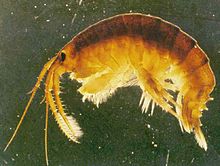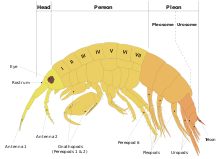
Amphipoda is an order of malacostracan crustaceans with no carapace and generally with laterally compressed bodies. Amphipods range in size from 1 to 340 millimetres and are mostly detritivores or scavengers. There are more than 9,900 amphipod species so far described. They are mostly marine animals, but are found in almost all aquatic environments. Some 1,900 species live in fresh water, and the order also includes the terrestrial sandhoppers such as Talitrus saltator and Arcitalitrus sylvaticus.

The round goby is a euryhaline bottom-dwelling species of fish of the family Gobiidae. It is native to Central Eurasia, including the Black Sea and the Caspian Sea. Round gobies have established large non-native populations in the Baltic Sea, several major Eurasian rivers, and the North American Great Lakes.

The quagga mussel is a species of freshwater mussel, an aquatic bivalve mollusk in the family Dreissenidae. It has an average lifespan of 3 to 5 years.
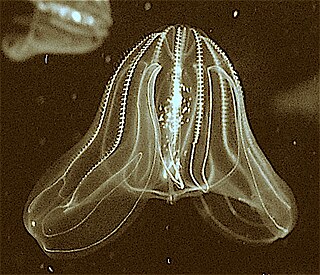
Mnemiopsis leidyi, the warty comb jelly or sea walnut, is a species of tentaculate ctenophore. It is native to western Atlantic coastal waters, but has become established as an invasive species in European and western Asian regions. Three species have been named in the genus Mnemiopsis, but they are now believed to be different ecological forms of a single species M. leidyi by most zoologists.
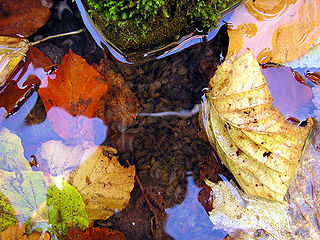
Gammarus pulex is a species of amphipod crustacean found in fresh water across much of Europe. It is a greyish animal, growing to 21 mm (0.83 in) long.

Gammaridae is a family of amphipods. In North America they are included among the folk taxonomic category of "scuds", and otherwise gammarids is usually used as a common name.

Gammarus roeselii is a species of freshwater amphipod native to Europe.

Gammarus is an amphipod crustacean genus in the family Gammaridae. It contains more than 200 described species, making it one of the most species-rich genera of crustaceans. Different species have different optimal conditions, particularly in terms of salinity, and different tolerances; Gammarus pulex, for instance, is a purely freshwater species, while Gammarus locusta is estuarine, only living where the salinity is greater than 25‰.

Gammarus desperatus, commonly known as Noel's Amphipod, is a species of small, amphipod crustacean in the family Gammaridae.
Gammarus hyalelloides is a species of amphipod crustacean in the family Gammaridae. It is endemic to four springs in Jeff Davis County and Reeves County, Texas, and is listed as a vulnerable species on the IUCN Red List.

Gammarus lacustris is an aquatic amphipod.
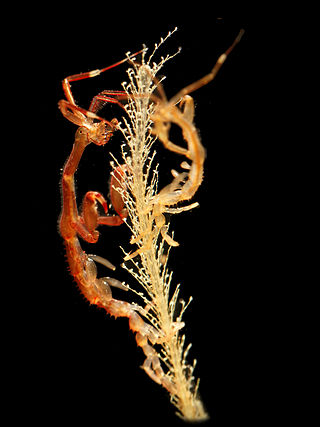
Caprella mutica, commonly known as the Japanese skeleton shrimp, is a species of skeleton shrimp. They are relatively large caprellids, reaching a maximum length of 50 mm (2.0 in). They are sexually dimorphic, with the males usually being much larger than the females. They are characterized by their "hairy" first and second thoracic segments and the rows of spines on their bodies. Body color ranges from green to red to blue, depending on the environment. They are omnivorous highly adaptable opportunistic feeders. In turn, they provide a valuable food source for fish, crabs, and other larger predators. They are usually found in dense colonies attached to submerged man-made structures, floating seaweed, and other organisms.
Dikerogammarus haemobaphes is a species of freshwater gammarid crustacean. These gammarids are commonly known as demon shrimp, likely because they are an extremely successful invasive species.
Gammarus baysali is a cave-dwelling species of freshwater amphipod crustacean, found in Turkey. The species belongs to the broader Gammarus pulex group and was scientifically described in 2013 from Cumayanı Cave, Zonguldak Province.
The microsporidian Cucumispora dikerogammari is a parasitic fungal species that infects the invasive amphipod Dikerogammarus villosus. The first recorded evidence of Cucumispora dikerogammari was, as cited by Ovcharenko and Vita, in Germany, circa 1895, by Dr. L. Pfeiffer in the Dnieper Estuary. The Dnieper Estuary and lower parts of the Danube River are considered to be the parasite’s native range. As its host, D. villosus, began to invade novel habitats, C. dikerogammari followed, and has now expanded its range to be found in many of the main bodies of water in Central and Western Europe. At this time, only limited research has been conducted regarding the ecological implications of C. dikerogammari spreading beyond its native range. However, there is evidence to suggest that C. dikerogammari may cause imbalance to the male/female sex ratio of its host D. villosus.
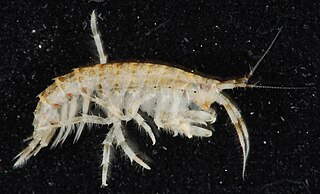
Gammarus mucronatus is a species of scud in the family Gammaridae. It is found in the coasts of the North American Atlantic seaboard and the Gulf of Mexico.
Crangonyx floridanus is a species of amphipod. Also known as the Florida crangonyx, Crangonyx floridanus is a small omnivorous, freshwater amphipod. These freshwater amphipods originated from North America. They have a high invasion potential due to their high growth rate and wide ecological amplitude. Their growth rates have a substantial effect on local populations of the natural communities. Native populations may be reduced or eliminated by this invading species.

Gammarus fossarum is a species complex of freshwater amphipod crustacean native to Europe. They are abundant members of the macroinvertebrate community, and also used as model organisms for ecotoxicology.
